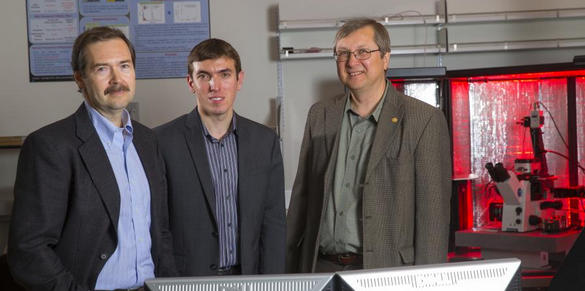BTN.com staff, February 16, 2015
Computers, smartphones, tablets, gaming systems. In a short period of time - in some cases, a span of just a couple of years - we?ve gone from marveling at these devices to demanding that companies make them better, faster, more portable.
Research from a team of scientists at the University of Nebraska could give the people what they want, and then some. Their work has the potential to significantly improve the speed, capacity and dependability of device memory through the use of what are called ?ferroelectric tunnel junctions.?
As explained by Dr. Alexei Gruverman, a Nebraska physics professor and co-author of the research recently published in Nature Communications, the team examined ferroelectrics - that is, polar dielectric materials, which are akin to magnets with electrical properties.
These are the same materials used in ferroelectric random access memory (FRAM), a mature technology that is found in products ranging from the Sony PlayStation to smart ID cards. However, ferroelectrics have certain limitations, Gruverman said.
?The information is read out by switching the polarization, which means that the information has to be restored after reading,? he explained. ?This consumes a lot of power and takes time. Besides, additional problems with this technology arise when you want to make it smaller; reading information will become more difficult.?
To investigate the physical and functional properties of these various materials, the research team at Nebraska used incredibly small conducting needles to uncover ferroelectric tunnel junctions, which are found in the sub-micrometer size range.
?In addition to faster speed and lower power consumption, these ferroelectric tunnel junctions can be scaled down significantly in comparison to the existing ferroelectric memory technology,? Gruverman said.
Scalability provides a higher memory density, allowing scientists to store much more information (in terms of terabytes per square inch) on the same area.
A new twist that Gruverman and his team brought to this experiment was using electrodes made of graphene, an incredibly thin material - just a single atomic layer, which is about 100,000 times thinner than a sheet of paper - composed of carbon atoms. This resulted in non-volatile memory, meaning the data is not lost when the device is powered off.
?This new technology has very strong potential because in this case we only need to measure the resistance, not the amount of charge that is stored in each memory cell and we don?t need to restore the information after reading,? Gruverman said. ?That?s the biggest advantage of the emerging technology. It is faster, and it consumes less power.
?They are interested in getting real functional devices stemming from this research,? he added. ?There is a lot of potential here.?
Sophisticated scientific work like this often involves a great deal of collaboration and support. The UNL Materials Research Science and Engineering Center (MRSEC) and Physics department provided its equipment and facilities for the team?s use. And along a renewal of support from the National Science Foundation for MRSEC, the university joined the recently formed Center for NanoFerroic Devices, a collaborative initiative involving colleges across the country that?s supported by a consortium of private companies.
Gruverman also cited the assistance of colleagues like Nebraska professors Evgeny Tsymbal, who provided much of the theoretical support needed for this work, and Alexander Sinitskii, who was in charge of graphene electrodes fabrication. And professor Chang-Beom Eom of the University of Wisconsin provided high-quality ferroelectric thin films for this study.
?In this kind of cutting-edge research it is extremely important to be in touch with the right people,? Gruverman said. ?Here at UNL, I have very good colleagues. Without them, I wouldn?t be able to move forward.?
By Betsy Piland







